tyre pressure JAGUAR XJ 2004 X350 / 3.G Owners Manual
[x] Cancel search | Manufacturer: JAGUAR, Model Year: 2004, Model line: XJ, Model: JAGUAR XJ 2004 X350 / 3.GPages: 227, PDF Size: 4.22 MB
Page 3 of 227
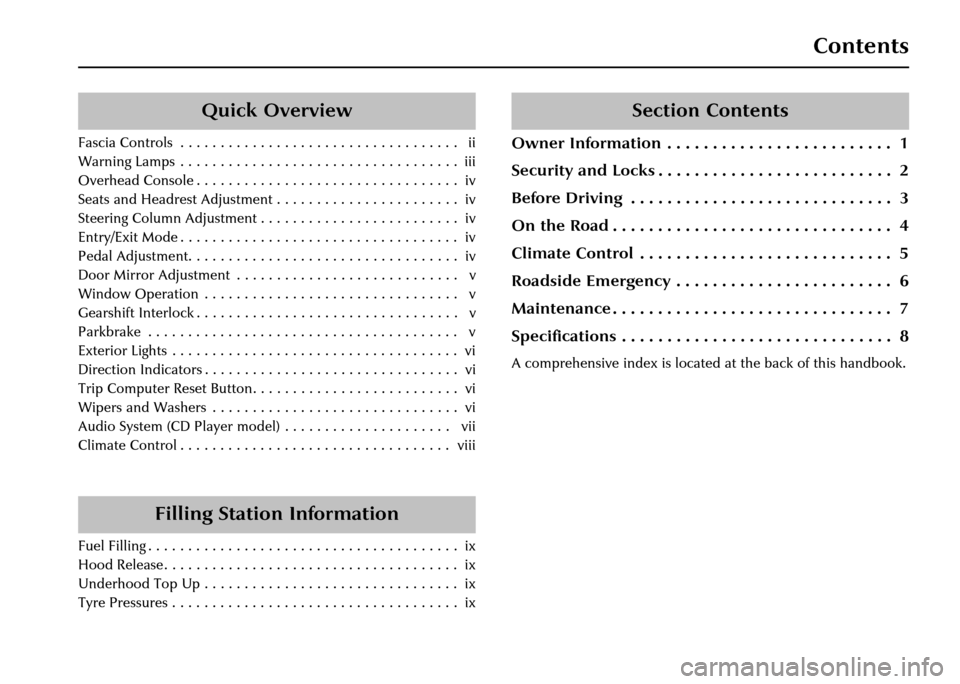
Contents
Section Contents
Owner Information . . . . . . . . . . . . . . . . . . . . . . . . . 1
Security and Locks . . . . . . . . . . . . . . . . . . . . . . . . . . 2
Before Driving . . . . . . . . . . . . . . . . . . . . . . . . . . . . . 3
On the Road . . . . . . . . . . . . . . . . . . . . . . . . . . . . . . . 4
Climate Control . . . . . . . . . . . . . . . . . . . . . . . . . . . . 5
Roadside Emergency . . . . . . . . . . . . . . . . . . . . . . . . 6
Maintenance . . . . . . . . . . . . . . . . . . . . . . . . . . . . . . . 7
Specifications . . . . . . . . . . . . . . . . . . . . . . . . . . . . . . 8
A comprehensive index is located at the back of this handbook.
Quick Overview
Fascia Controls . . . . . . . . . . . . . . . . . . . . . . . . . . . . . . . . . . . ii
Warning Lamps . . . . . . . . . . . . . . . . . . . . . . . . . . . . . . . . . . . iii
Overhead Console . . . . . . . . . . . . . . . . . . . . . . . . . . . . . . . . . iv
Seats and Headrest Adjustment . . . . . . . . . . . . . . . . . . . . . . . iv
Steering Column Adjustment . . . . . . . . . . . . . . . . . . . . . . . . . iv
Entry/Exit Mode . . . . . . . . . . . . . . . . . . . . . . . . . . . . . . . . . . . iv
Pedal Adjustment. . . . . . . . . . . . . . . . . . . . . . . . . . . . . . . . . . iv
Door Mirror Adjustment . . . . . . . . . . . . . . . . . . . . . . . . . . . . v
Window Operation . . . . . . . . . . . . . . . . . . . . . . . . . . . . . . . . v
Gearshift Interlock . . . . . . . . . . . . . . . . . . . . . . . . . . . . . . . . . v
Parkbrake . . . . . . . . . . . . . . . . . . . . . . . . . . . . . . . . . . . . . . . v
Exterior Lights . . . . . . . . . . . . . . . . . . . . . . . . . . . . . . . . . . . . vi
Direction Indicators . . . . . . . . . . . . . . . . . . . . . . . . . . . . . . . . vi
Trip Computer Reset Button. . . . . . . . . . . . . . . . . . . . . . . . . . vi
Wipers and Washers . . . . . . . . . . . . . . . . . . . . . . . . . . . . . . . vi
Audio System (CD Player model) . . . . . . . . . . . . . . . . . . . . . vii
Climate Control . . . . . . . . . . . . . . . . . . . . . . . . . . . . . . . . . . viii
Filling Station Information
Fuel Filling . . . . . . . . . . . . . . . . . . . . . . . . . . . . . . . . . . . . . . . ix
Hood Release . . . . . . . . . . . . . . . . . . . . . . . . . . . . . . . . . . . . . ix
Underhood Top Up . . . . . . . . . . . . . . . . . . . . . . . . . . . . . . . . ix
Tyre Pressures . . . . . . . . . . . . . . . . . . . . . . . . . . . . . . . . . . . . ix
Page 118 of 227
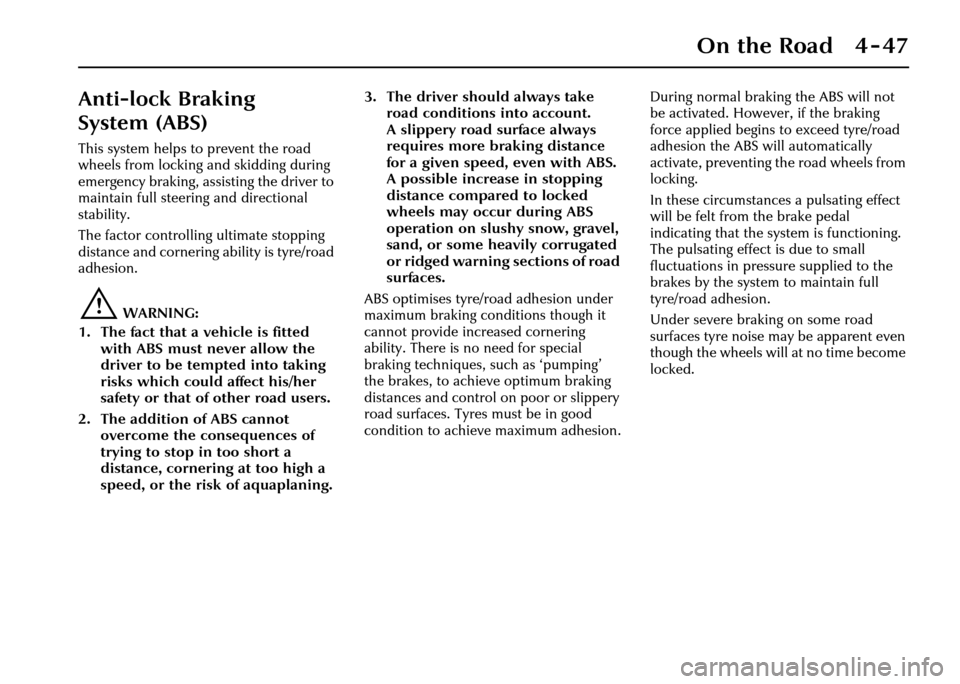
On the Road 4 - 47
Anti-lock Braking
System (ABS)
This system helps to prevent the road
wheels from locking and skidding during
emergency braking, assisting the driver to
maintain full steering and directional
stability.
The factor controlling ultimate stopping
distance and cornering ability is tyre/road
adhesion.
!WARNING:
1. The fact that a vehicle is fitted with ABS must never allow the
driver to be tempted into taking
risks which could affect his/her
safety or that of other road users.
2. The addition of ABS cannot overcome the consequences of
trying to stop in too short a
distance, cornering at too high a
speed, or the risk of aquaplaning. 3. The driver should always take
road conditions into account.
A slippery road surface always
requires more braking distance
for a given speed, even with ABS.
A possible increase in stopping
distance compared to locked
wheels may occur during ABS
operation on slushy snow, gravel,
sand, or some heavily corrugated
or ridged warning sections of road
surfaces.
ABS optimises tyre/road adhesion under
maximum braking conditions though it
cannot provide increased cornering
ability. There is no need for special
braking techniques, such as ‘pumping’
the brakes, to achieve optimum braking
distances and control on poor or slippery
road surfaces. Tyres must be in good
condition to achieve maximum adhesion. During normal brakin
g the ABS will not
be activated. Howe ver, if the braking
force applied begins to exceed tyre/road
adhesion the ABS will automatically
activate, preventing the road wheels from
locking.
In these circumstances a pulsating effect
will be felt from the brake pedal
indicating that the sy stem is functioning.
The pulsating effect is due to small
fluctuations in pressure supplied to the
brakes by the system to maintain full
tyre/road adhesion.
Under severe braking on some road
surfaces tyre noise may be apparent even
though the wheels will at no time become
locked.
Page 133 of 227
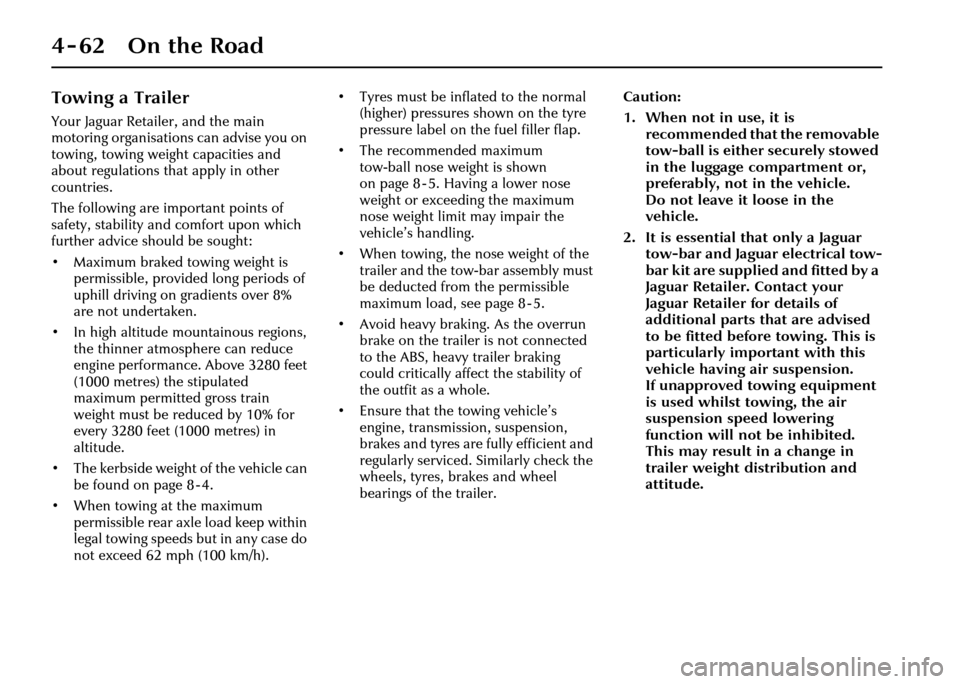
4-62 On the Road
Towing a Trailer
Your Jaguar Retailer, and the main
motoring organisations can advise you on
towing, towing weight capacities and
about regulations that apply in other
countries.
The following are important points of
safety, stability and comfort upon which
further advice should be sought:
• Maximum braked towing weight is permissible, provided long periods of
uphill driving on gradients over 8%
are not undertaken.
• In high altitude mountainous regions, the thinner atmosphere can reduce
engine performance. Above 3280 feet
(1000 metres) the stipulated
maximum permitted gross train
weight must be reduced by 10% for
every 3280 feet (1000 metres) in
altitude.
• The kerbside weight of the vehicle can be found on page 8 - 4.
• When towing at the maximum permissible rear axle load keep within
legal towing speeds but in any case do
not exceed 62 mph (100 km/h). • Tyres must be inflated to the normal
(higher) pressures shown on the tyre
pressure label on the fuel filler flap.
• The recommended maximum tow-ball nose weight is shown
on page 8 - 5. Having a lower nose
weight or exceeding the maximum
nose weight limit may impair the
vehicle’s handling.
• When towing, the nose weight of the trailer and the tow-bar assembly must
be deducted from the permissible
maximum load, see page 8 - 5.
• Avoid heavy braking. As the overrun brake on the traile r is not connected
to the ABS, heavy trailer braking
could critically affect the stability of
the outfit as a whole.
• Ensure that the towing vehicle’s engine, transmission, suspension,
brakes and tyres are fully efficient and
regularly serviced. Similarly check the
wheels, tyres, brakes and wheel
bearings of the trailer. Caution:
1. When not in use, it is
recommended that the removable
tow-ball is either securely stowed
in the luggage compartment or,
preferably, not in the vehicle.
Do not leave it loose in the
vehicle.
2. It is essential that only a Jaguar tow-bar and Jaguar electrical tow-
bar kit are supplied and fitted by a
Jaguar Retailer. Contact your
Jaguar Retailer for details of
additional parts that are advised
to be fitted before towing. This is
particularly important with this
vehicle having air suspension.
If unapproved towing equipment
is used whilst towing, the air
suspension speed lowering
function will not be inhibited.
This may result in a change in
trailer weight distribution and
attitude.
Page 136 of 227
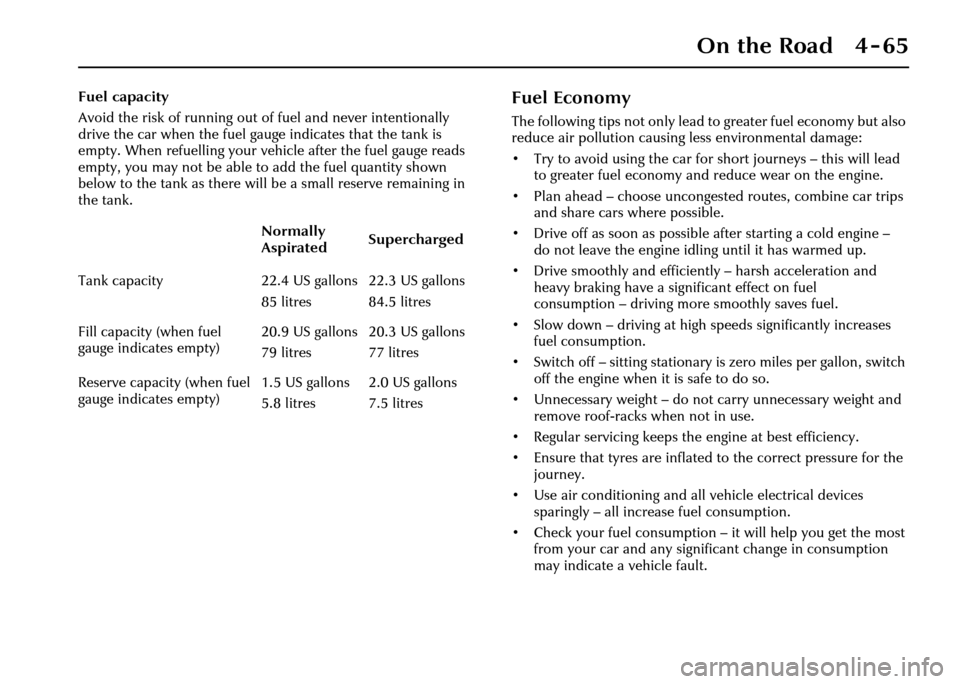
On the Road 4 - 65
Fuel capacity
Avoid the risk of running out of fuel and never intentionally
drive the car when the fuel gauge indicates that the tank is
empty. When refuelling your vehicle after the fuel gauge reads
empty, you may not be able to add the fuel quantity shown
below to the tank as there will be a small reserve remaining in
the tank.Fuel Economy
The following tips not only lead to greater fuel economy but also
reduce air pollution causing less environmental damage:
• Try to avoid using the car for short journeys – this will lead
to greater fuel economy and reduce wear on the engine.
• Plan ahead – choose uncongested routes, combine car trips and share cars where possible.
• Drive off as soon as possible after starting a cold engine – do not leave the engine idling until it has warmed up.
• Drive smoothly and efficiently – harsh acceleration and heavy braking have a significant effect on fuel
consumption – driving more smoothly saves fuel.
• Slow down – driving at high speeds significantly increases fuel consumption.
• Switch off – sitting stationary is zero miles per gallon, switch
off the engine when it is safe to do so.
• Unnecessary weight – do not carry unnecessary weight and remove roof-racks when not in use.
• Regular servicing keeps the engine at best efficiency.
• Ensure that tyres are inflated to the correct pressure for the journey.
• Use air conditioning and all vehicle electrical devices sparingly – all increase fuel consumption.
• Check your fuel consumption – it will help you get the most from your car and any significant change in consumption
may indicate a vehicle fault.
Normally
Aspirated
Supercharged
Tank capacity 22.4 US gallons
85 litres 22.3 US gallons
84.5 litres
Fill capacity (when fuel
gauge indicates empty) 20.9 US gallons
79 litres20.3 US gallons
77 litres
Reserve capacity (when fuel
gauge indicates empty) 1.5 US gallons
5.8 litres2.0 US gallons
7.5 litres
Page 139 of 227
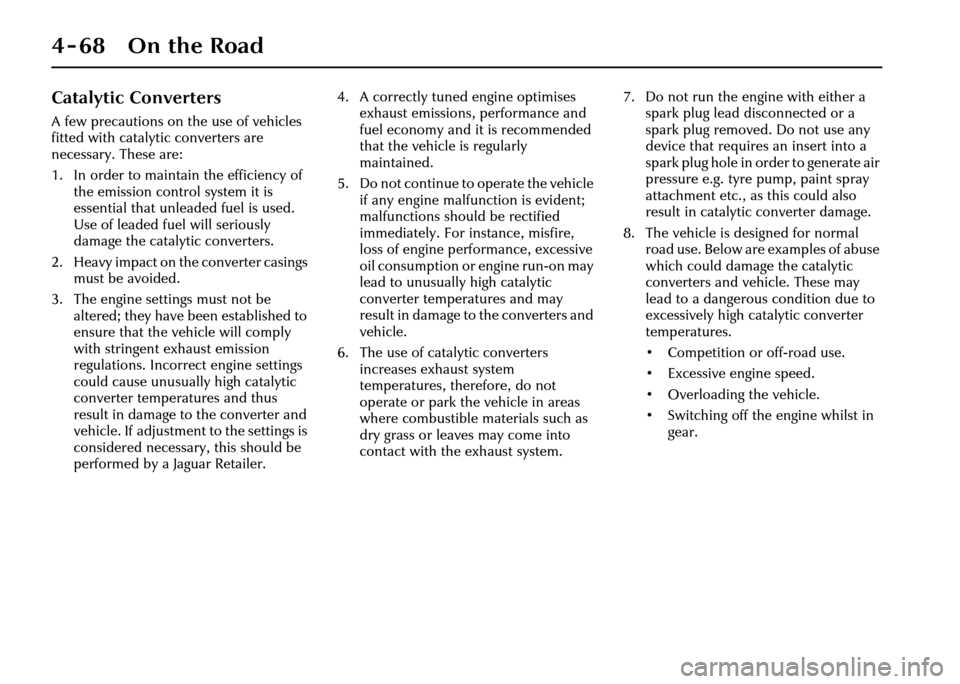
4-68 On the Road
Catalytic Converters
A few precautions on the use of vehicles
fitted with catalytic converters are
necessary. These are:
1. In order to maintain the efficiency of the emission control system it is
essential that unleaded fuel is used.
Use of leaded fuel will seriously
damage the catalytic converters.
2. Heavy impact on the converter casings must be avoided.
3. The engine settings must not be altered; they have been established to
ensure that the vehicle will comply
with stringent exhaust emission
regulations. Incorrect engine settings
could cause unusually high catalytic
converter temperatures and thus
result in damage to the converter and
vehicle. If adjustment to the settings is
considered necessary, this should be
performed by a Jaguar Retailer. 4. A correctly tuned engine optimises
exhaust emissions, performance and
fuel economy and it is recommended
that the vehicle is regularly
maintained.
5. Do not continue to operate the vehicle if any engine malfunction is evident;
malfunctions should be rectified
immediately. For instance, misfire,
loss of engine performance, excessive
oil consumption or engine run-on may
lead to unusually high catalytic
converter temperatures and may
result in damage to the converters and
vehicle.
6. The use of catalytic converters increases exhaust system
temperatures, therefore, do not
operate or park the vehicle in areas
where combustible materials such as
dry grass or leaves may come into
contact with the exhaust system. 7. Do not run the engine with either a
spark plug lead disconnected or a
spark plug removed. Do not use any
device that requires an insert into a
spark plug hole in order to generate air
pressure e.g. tyre pump, paint spray
attachment etc., as this could also
result in catalyti c converter damage.
8. The vehicle is designed for normal road use. Below are examples of abuse
which could damage the catalytic
converters and vehicle. These may
lead to a dangerous condition due to
excessively high catalytic converter
temperatures.
• Competition or off-road use.
• Excessive engine speed.
• Overloading the vehicle.
• Switching off the engine whilst in gear.
Page 157 of 227
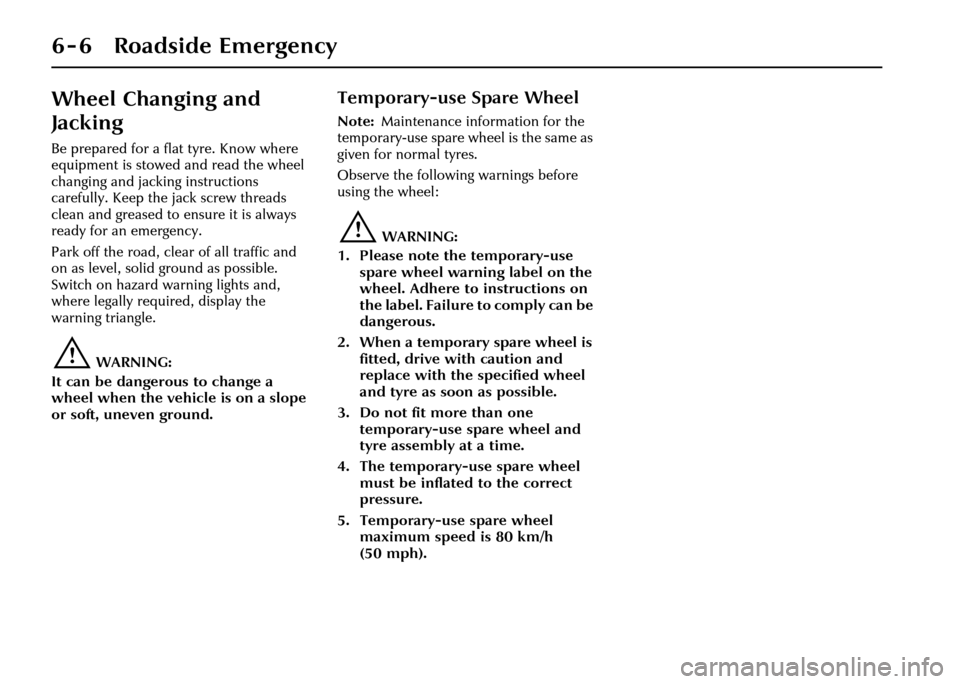
6 - 6 Roadside Emergency
Wheel Changing and
Jacking
Be prepared for a flat tyre. Know where
equipment is stowed and read the wheel
changing and jacking instructions
carefully. Keep the jack screw threads
clean and greased to ensure it is always
ready for an emergency.
Park off the road, clear of all traffic and
on as level, solid ground as possible.
Switch on hazard warning lights and,
where legally required, display the
warning triangle.
!WARNING:
It can be dangerous to change a
wheel when the vehicle is on a slope
or soft, uneven ground.
Temporary-use Spare Wheel
Note: Maintenance information for the
temporary-use spare wheel is the same as
given for normal tyres.
Observe the following warnings before
using the wheel:
!WARNING:
1. Please note th e temporary-use
spare wheel warning label on the
wheel. Adhere to instructions on
the label. Failure to comply can be
dangerous.
2. When a temporary spare wheel is fitted, drive with caution and
replace with the specified wheel
and tyre as soon as possible.
3. Do not fit more than one temporary-use spare wheel and
tyre assembly at a time.
4. The temporary-use spare wheel must be inflated to the correct
pressure.
5. Temporary-use spare wheel maximum speed is 80 km/h
(50 mph).
Page 163 of 227

6 - 12 Roadside Emergency
Transporter tie-down procedure
!WARNING:
Avoid body contact with a hot
exhaust pipe when securing the
vehicle to the transporter.
IMPORTANT – Use straps over the
wheels/tyres only, to secure the vehicle to
the transporter.
Caution: Do not use the tie-down
brackets on the vehicle rear
underbody; these are for Jaguar
factory use only. In time, with the
engine switched off, the vehicle body
will drop due to settling of the air
suspension system and cause the tie-
down chains/straps to become slack if
connected to these brackets.
The towing eye is not designed for
securing the vehicle during
transportation. Vehicle failure
The removable towing eye is primarily for
emergency use when towing for SHORT
DISTANCES, e.g. removing the vehicle if it
is causing an obstruct
ion or for winching
the vehicle onto a re covery transporter.
To prevent damage to the automatic
transmission whilst the vehicle is being
towed with the rear wheels on the
ground, towing distance must be
restricted to 0.5 miles (0.8 kilometres).
Towing speed must not exceed 30 mph
(48 km/h).
Always obey towing regulations.
In certain countries the registration
number of the towing vehicle and an
‘ON TOW’ sign or warning triangle must
be displayed in a prominent position at
the rear of the vehicle being towed. When being towed, the gear selector
lever must be in neutral (position ‘N’)
with the ignition key turned to
position ‘II’ to release the steering lock
and render the indicators, horn and
brake lights operational.
!WARNING:
When the engine is not running the
steering and brakes will no longer be
power-assisted.
Therefore, be prepared for relatively
heavy steering and the need for
greatly increased brake pedal
pressure.
Page 184 of 227

Maintenance
Regular Checks . . . . . . . . . . . . . . . . . . . . . . . . . . 7 - 3
Hood Release . . . . . . . . . . . . . . . . . . . . . . . . . . . 7 - 4
Checking and Top Up . . . . . . . . . . . . . . . . . . . . . 7 - 6
Check Engine Oil Level . . . . . . . . . . . . . . . . . . . . 7 - 6
Check Power Steering Fluid Level . . . . . . . . . . . . 7 - 8
Check Brake Fluid Reservoir . . . . . . . . . . . . . . . . 7 - 9
Check Windscreen/Headlight Washer Reservoir. . . . . . . . . . . . . . . . . . . . . . . . . . . 7 - 10
Check Coolant Level . . . . . . . . . . . . . . . . . . . . . 7 - 11
Capacities . . . . . . . . . . . . . . . . . . . . . . . . . . . . . 7 - 12
Battery . . . . . . . . . . . . . . . . . . . . . . . . . . . . . . . 7 - 13
Battery Warning Signs. . . . . . . . . . . . . . . . . . . . 7 - 14
Check/Top Up Battery Electrolyte . . . . . . . . . . . 7 - 15
Windscreen Wipers . . . . . . . . . . . . . . . . . . . . . 7 - 17
Tyres . . . . . . . . . . . . . . . . . . . . . . . . . . . . . . . . 7 - 18
Tyre Pressures . . . . . . . . . . . . . . . . . . . . . . . . . 7 - 18
Vehicle Care . . . . . . . . . . . . . . . . . . . . . . . . . . . 7 - 22
Interior Care . . . . . . . . . . . . . . . . . . . . . . . . . . . 7 - 22
Exterior Care . . . . . . . . . . . . . . . . . . . . . . . . . . 7 - 23
Electrical Accessories . . . . . . . . . . . . . . . . . . . . 7 - 25
Page 186 of 227
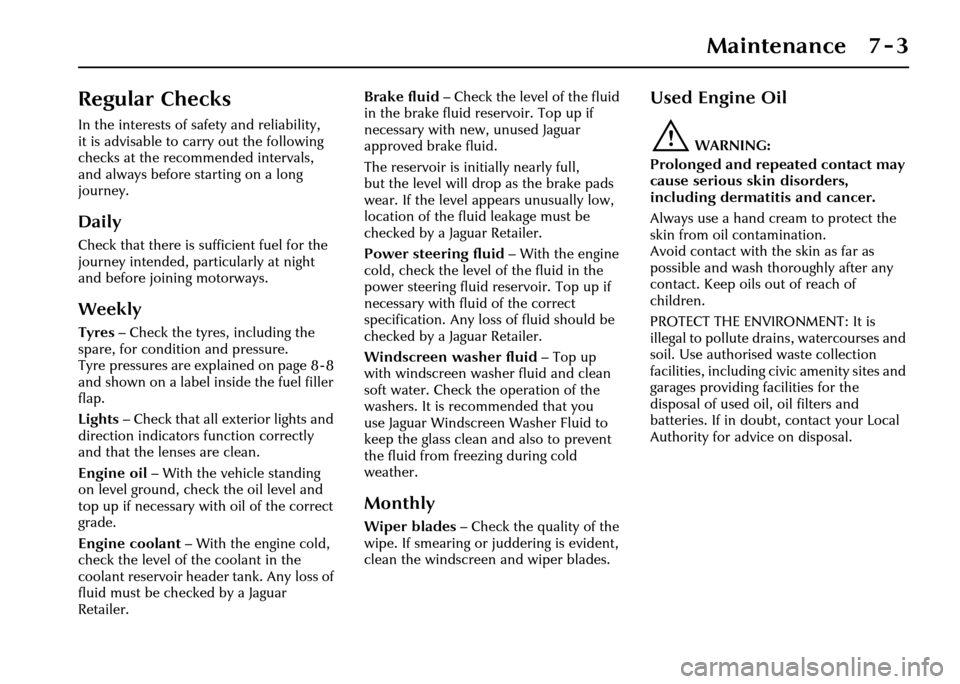
Maintenance 7 - 3
7 Maintenance
Regular Checks
In the interests of safety and reliability,
it is advisable to carry out the following
checks at the recommended intervals,
and always before starting on a long
journey.
Daily
Check that there is sufficient fuel for the
journey intended, particularly at night
and before joining motorways.
Weekly
Tyres– Check the tyres, including the
spare, for condition and pressure.
Tyre pressures are explained on page 8 - 8
and shown on a label inside the fuel filler
flap.
Lights – Check that all exterior lights and
direction indicators function correctly
and that the lenses are clean.
Engine oil – With the vehicle standing
on level ground, check the oil level and
top up if necessary with oil of the correct
grade.
Engine coolant – With the engine cold,
check the level of the coolant in the
coolant reservoir header tank. Any loss of
fluid must be checked by a Jaguar
Retailer. Brake fluid
– Check the level of the fluid
in the brake fluid reservoir. Top up if
necessary with new, unused Jaguar
approved brake fluid.
The reservoir is initially nearly full,
but the level will drop as the brake pads
wear. If the level appears unusually low,
location of the fluid leakage must be
checked by a Jaguar Retailer.
Power steering fluid – With the engine
cold, check the level of the fluid in the
power steering fluid reservoir. Top up if
necessary with fluid of the correct
specification. Any loss of fluid should be
checked by a Jaguar Retailer.
Windscreen washer fluid – Top up
with windscreen washer fluid and clean
soft water. Check the operation of the
washers. It is recommended that you
use Jaguar Windscreen Washer Fluid to
keep the glass clean and also to prevent
the fluid from freezing during cold
weather.
Monthly
Wiper blades – Check the quality of the
wipe. If smearing or juddering is evident,
clean the windscreen and wiper blades.
Used Engine Oil
!WARNING:
Prolonged and repeated contact may
cause serious skin disorders,
including dermatitis and cancer.
Always use a hand cream to protect the
skin from oil contamination.
Avoid contact with the skin as far as
possible and wash thoroughly after any
contact. Keep oils out of reach of
children.
PROTECT THE ENVIRONMENT: It is
illegal to pollute drai ns, watercourses and
soil. Use authorised waste collection
facilities, including civic amenity sites and
garages providing fa cilities for the
disposal of used oi l, oil filters and
batteries. If in doubt, contact your Local
Authority for advice on disposal.
Page 201 of 227
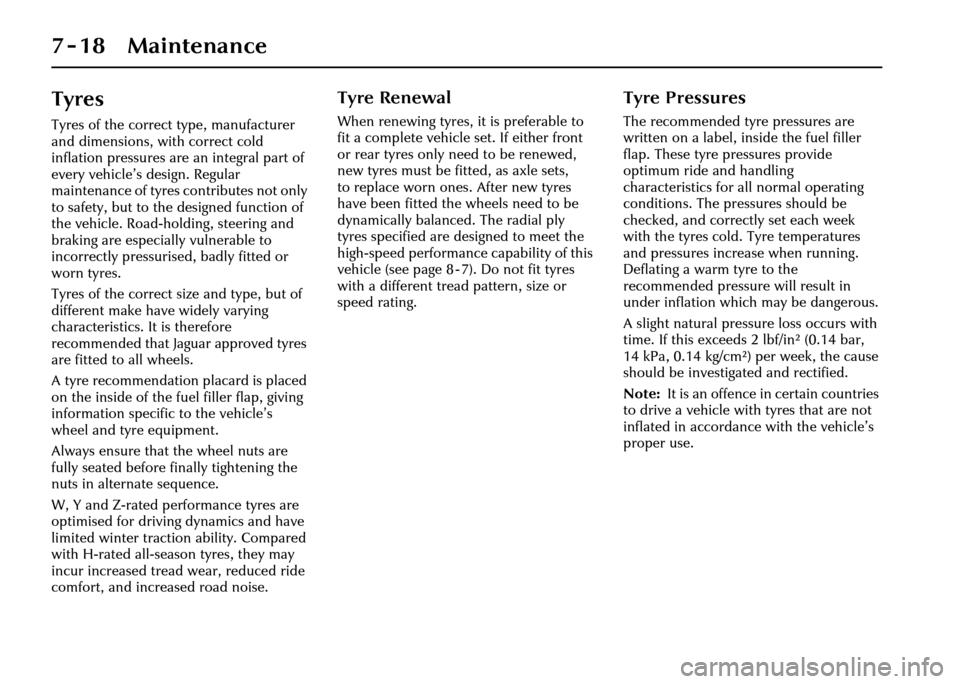
7-18 Maintenance
Tyres
Tyres of the correct type, manufacturer
and dimensions, with correct cold
inflation pressures are an integral part of
every vehicle’s design. Regular
maintenance of tyres contributes not only
to safety, but to the de signed function of
the vehicle. Road-holding, steering and
braking are especially vulnerable to
incorrectly pressurised, badly fitted or
worn tyres.
Tyres of the correct size and type, but of
different make have widely varying
characteristics. It is therefore
recommended that Jaguar approved tyres
are fitted to all wheels.
A tyre recommendation placard is placed
on the inside of the fuel filler flap, giving
information specific to the vehicle’s
wheel and tyre equipment.
Always ensure that the wheel nuts are
fully seated before finally tightening the
nuts in alternate sequence.
W, Y and Z-rated performance tyres are
optimised for driving dynamics and have
limited winter traction ability. Compared
with H-rated all-season tyres, they may
incur increased tread wear, reduced ride
comfort, and increased road noise.
Tyre Renewal
When renewing tyres, it is preferable to
fit a complete vehicle set. If either front
or rear tyres only need to be renewed,
new tyres must be fitted, as axle sets,
to replace worn ones. After new tyres
have been fitted the wheels need to be
dynamically balanced. The radial ply
tyres specified are designed to meet the
high-speed performance capability of this
vehicle (see page 8 - 7) . Do not fit tyres
with a different tread pattern, size or
speed rating.
Tyre Pressures
The recommended tyre pressures are
written on a label, inside the fuel filler
flap. These tyre pressures provide
optimum ride and handling
characteristics for all normal operating
conditions. The pressures should be
checked, and correctly set each week
with the tyres cold. Tyre temperatures
and pressures increase when running.
Deflating a warm tyre to the
recommended pressure will result in
under inflation whic h may be dangerous.
A slight natural pressure loss occurs with
time. If this exceeds 2 lbf/in² (0.14 bar,
14 kPa, 0.14 kg/cm²) per week, the cause
should be investigated and rectified.
Note: It is an offence in certain countries
to drive a vehicle with tyres that are not
inflated in accordance with the vehicle’s
proper use.